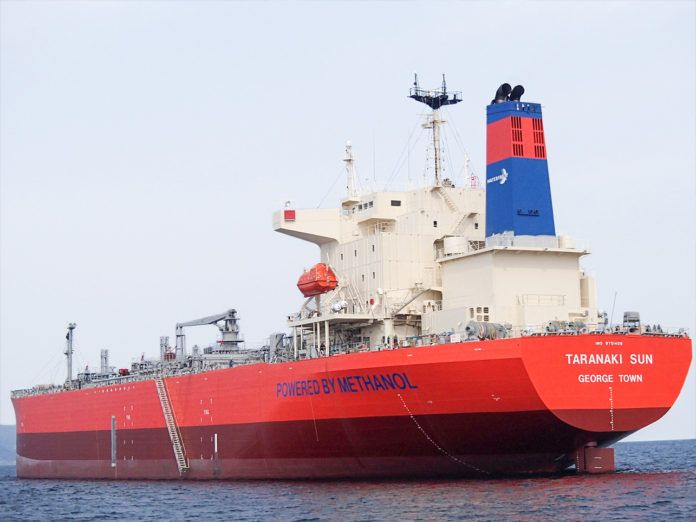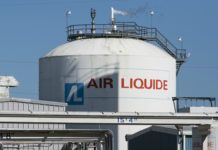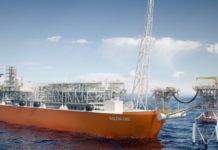Despite lower oil and gas prices, some methanol producers feel they are on the cusp of a boom, encouraged by the advent of new marine fuel applications and rising Chinese demand in the energy and methanol to olefins sectors.
The industry is particularly excited about the potential of new marine applications for methanol. In April, Waterfront Shipping, a subsidiary of the world’s largest methanol producer, Methanex, launched seven 50,000-ton marine vessels built with dual-fuel engines that can run on methanol, fuel oil, marine diesel oil or gas oil.
The conversion will enable the vessels to comply with a 2020 deadline imposed by the International Maritime Organization, an agency of the United Nations, to reduce marine fuel sulfur content to less than 0.5% globally. Waterfront also operates the world’s largest methanol ocean tanker fleet, with 22 deep sea tankers maintaining an uninterrupted flow of methanol to storage terminals and plant sites around the world.
Greg Dolan, CEO of Washington, D.C.-based industry group Methanol Institute, says the cleaner burning methanol is a promising alternative fuel for ships. “Currently, there are some 90,000 vessels on the world’s oceans that consume about 370 million tons of bunker fuel, which is typically a high-sulfur diesel fuel,” Dolan says. “It’s estimated that a single large container ship can produce as much sulfur dioxide as 50 million cars.”
While other available fuels burn less sulfur, such as marine gas oil or liquefied natural gas, these options often come with a premium. Dolan says the low-cost simplicity of converting methanol to marine fuel is its greatest attribute.
“It’s not rocket science,” he says. “There is a simple conversion that they make. Methanol is already one of the top five chemical commodities shipped around the world—now we’re looking at just moving the methanol from the ship’s cargo hold to its bunker where they keep their fuels.”
By converting to methanol, large ocean-going vessels can reduce sulfur dioxide emissions by 99%, nitrogen oxide emission by 60% and particulate matter by 95%. This is important to port cities such as Baton Rouge and New Orleans, where pollutants discharged by shipping vessels can create “pollution islands.”
“Anything you can do to introduce cleaner burning fuels for those inland waterway vessels will have an immediate impact,” Dolan says.
The innovative engines used in the Waterfront vessels were manufactured by MAN Diesel & Turbo SE, headquartered in Augsburg, Germany. “MAN developed these two-stroke engines in response to interest from the shipping world to operate on alternatives to heavy fuel oil and meet increasingly stringent emissions regulations,” says Ole Grøne, MAN senior vice president, in a news release. “To hedge the risk of fuel price volatility, the vessels can switch between fuels, and operate cost-effectively.” The engine expands the company’s dual-fuel portfolio, also enabling the use of other fuels such as liquefied natural gas.
Meg Mahoney, public affairs manager at the Methanex plant in Geismar, says it’s difficult to predict how advances in marine applications might impact the local plant. “I think it would be too early to speculate on the direct impact to Geismar,” Mahoney says. “However, any new market for methanol is positive for our industry overall.”
Still, she won’t rule out the possibility of future expansions to meet general demand growth. “We have looked at a potential third plant in Geismar as part of our ongoing process to grow business,” Mahoney says. “I don’t have any more information at this time … but it is a possibility.”
At a combined cost of $1.4 billion, the Vancouver-based company has relocated a pair of plants from Chile to Geismar, the second of which began producing in December 2015, three months ahead of schedule. North America is a key global market, and moving its assets to the region enabled the company to supply customers in a more reliable way. “There is also an abundance of competitively priced natural gas in the U.S., and in Geismar we have access to a very talented workforce that is skilled in chemical production,” Mahoney explains.
Anticipated growth in demand for methanol has led to other investments in Louisiana. Houston-based G2X Energy broke ground in mid-January 2016 on a $1.6 billion methanol plant in Lake Charles. The 200-acre Big Lake Fuels Methanol Plant is expected to produce 1.4 million metric tons of commercial grade methanol per year upon completion in 2019. It will also be capable of converting methanol into automotive gasoline.
In St. James Parish, China-based Shandong Yuhuang Chemical Inc. broke ground in September 2015 on a $1.85 billion methanol plant, to be built in three phases. The first phase, which company officials have said is expected to be up and running in the first quarter of 2018, will be a methanol plant expected to produce 1.7 million tons annually.
Some methanol producers, however, don’t appear to be as bullish as others. Houston-based Syngas Energy CEO Vas Kenyen is more cautious, saying the $360 million, 130-acre plant announced last fall in St. James Parish has been put on hold until the second quarter of 2017. “The market conditions are slowing us down a bit,” Kenyen says. “We are moving forward with EPA permitting, but we don’t expect to break ground until conditions improve.”
Kenyen says cheap oil makes methanol a less attractive fuel source, thereby suppressing demand and reducing prices. At least for Syngas, demand for the product in China has not been enough to counter market fluctuations in the oil and gas sector.
While new marine fuel applications are a promising source of new demand, approximately 60% of current use of methanol comes from other sources. Methanex Global Market Development Senior Manager Jason Chesko says the energy market has seen the most significant growth.
“If you look at methanol today, it’s being used primarily as a vehicle fuel, in power generation and in bio-diesel fuel,” Chesko says. “The industry is growing at a pretty high rate. A large part of that is being driven by the use of methanol for energy applications. Power generation, biodiesel … that’s where we’re seeing the higher growth rates.”
Still, as much as 60% of demand comes from chemical derivatives. “Methanol is the building block for hundreds of products that touch our lives daily—paints, plastics, solvents, resins … they all use methanol,” the Methanol Institute’s Dolan says. “It’s a very simple molecule, which makes it a good building block for making other things.”
By far, China is methanol’s biggest consumer, despite a leveling off of the economy there. A growing market in China is the conversion of methanol to olefins, which are a raw material used to create synthetic rubber and plastics, among other products.
“On a global basis, global methanol demand in 2015 was 70 million metric tons,” Dolan says. “Of that demand, probably 40% of it was in China. In fact, last year the Chinese consumed 7 million metric tons of methanol in their cars, trucks and buses.”
Originally published in the fourth quarter 2016 edition of 10/12 Industry Report.









